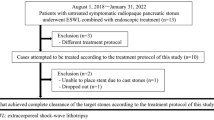Abstract
In recent years, alternatives to surgery for difficult bile duct stones have been developed. Routine endoscopy fails in about 10% of patients. To verify the role of extracorporeal shock wave lithotripsy in residual CBD stones, we treated 32 patients by HM4 or MPL 9000 Dornier lithotripters. Ten (34.4%) patients needed two extracorporeal shock wave lithotripsy sessions, and 3 (10.3%) patients three. Complete clearance was achieved in 29 patients (90.6%) after one or more sessions either by endoscopic (20 pts) or percutaneous (9 pts) extraction of the debris; of the remaining 3 patients, in 2 a bilioduodenal stent was placed and in 1 electrohydraulic lithotripsy was performed. Eighteen and seven-tenths percent transient mild hemobilia, 12.5% microhematuria, and no mortality were observed. It is possible to state that in site- or size-related difficult biliary stones, extracorporeal shock wave lithotripsy is a rapid, safe, and highly effective treatment as an additional nonoperative option to resolve the failure of routine endoscopic measures.
Similar content being viewed by others
References
McSherry CK, Glenn F: The incidence and causes of death following surgery for non-malignant biliary tract disease. Ann Surg 191:271–275, 1980
Sullivan DM, Ruffin Hood T,et al.: Biliary tract surgery in the elderly. Am J Surg 143:218–220, 1982
Leuschner U, Seifert E: The role of endoscopy in the endoscopy in the treatment of gallstones.In Problems in General Surgery, “Changing Concepts in Biliary Stones Management,” LM Nyhus (ed). Philadelphia, J. B. Lippincott, 1991, Vol 8, No 4, pp 617–627
Allen MJ, Borody TJ, Bugliosi TF, May GR, LaRusso NF, Thistle JL: Rapid dissolution of gallstones by methyl-tert-butyl ether fails to dissolve retained radiolucent common bile duct stones. Gastroenterology 91:1296–1300, 1986
Cotton PB, Kozarek RA, Shapiro RH,et al.: Endoscopic laser lithotripsy of large bile duct stones. Gastroenterology 99:1128–1133, 1990
Chaussy C, Eisenberger F, Wanner: The use of shock waves for the destruction of renal calculi without direct contact. Urol Res 4:175, 1976
Sauerbruch T, Delius M, Paumgartner G,et al.: Fragmentation of gallstones by extracorporeal shock waves. N Engl J Med 314:818–822, 1986
Sackmann M, Delius M, Sauerbruck T,et al.: Shock-wave lithotripsy of gallbladder stones: The first 175 patients. N Engl J Med 318:393, 1988
Sauerbruch T, Stern M,et al.: Fragmentation of bile duct stones by extracorporeal shock waves. A new approach to biliary calculi after failure of routine endoscopic measures. Gastroenterology 96:146–152, 1989
Owens WD, Felts JA, Spitznagel EL Jr: ASA physical status classification: a study of consistency of ratings. Anesthesiology 49:239, 1978
Binmoeller KF, Brückner M, Thonke F, Soehendra N: Treatment of difficult bile duct stones using mechanical, electrohydraulic and extracorporeal shock wave lithotripsy. Endoscopy 25:210–206, 1993
Wenzel H, Greiner L, Jacobeit C: Extracorporeal shock wave lithotripsy in problematic bile duct stones. Dtsch Med Wochenschr 114:738, 1989
Lomanto D, Greiner L: Nonsurgical approach to biliary stones: Extracorporeal shock-wave lithotripsy.In Problems in General Surgery, “Changing Concepts in Biliary Stones Management,” LM Nyhus (ed). Philadelphia, J. B. Lippincott, 1991, Vol 8, No 4, pp 657–672
Testoni PA, Lella F, Masci E, Bagnolo F, Colombo E, Tittobello A: Combined endoscopic and extracorporeal shock-wave treatment in difficult bile duct stones: Early- and long-term results. Ital J Gastroenterol 26:294–298, 1994
Speer AG, Webb DR, Collier NA, McHutchinson JG, St John DJB, Clunie GJA: Extracorporeal shock-wave lithotripsy and the management of common bile duct calculi. Med J Aust 148:590–595, 1988
Greiner L, Munks C, Heil W, Jakobeit C: Gallbladder stone fragments in feces after biliary extracorporeal shock-wave lithotripsy. Gastroenterology 98:1620–1624, 1990
Author information
Authors and Affiliations
Rights and permissions
About this article
Cite this article
Lomanto, D., Fiocca, F., Nardovino, M. et al. ESWL experience in the therapy of difficult bile duct stones. Digest Dis Sci 41, 2397–2403 (1996). https://doi.org/10.1007/BF02100134
Received:
Revised:
Accepted:
Issue Date:
DOI: https://doi.org/10.1007/BF02100134




